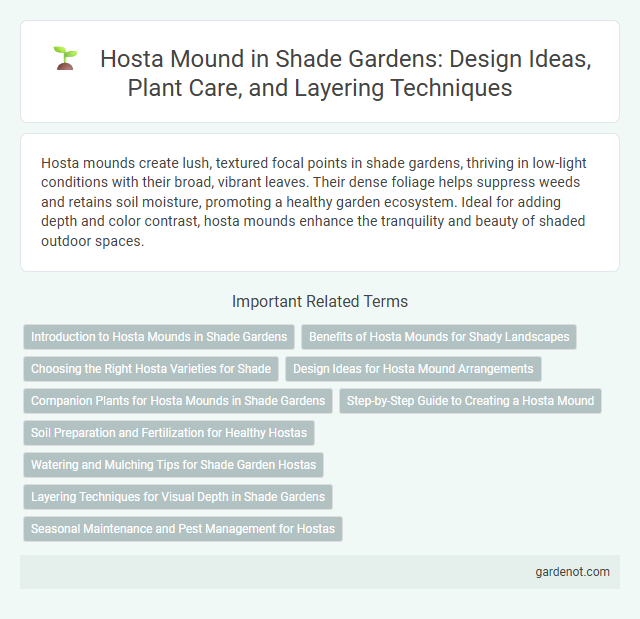Hosta mounds create lush, textured focal points in shade gardens, thriving in low-light conditions with their broad, vibrant leaves. Their dense foliage helps suppress weeds and retains soil moisture, promoting a healthy garden ecosystem. Ideal for adding depth and color contrast, hosta mounds enhance the tranquility and beauty of shaded outdoor spaces.
Introduction to Hosta Mounds in Shade Gardens
Hosta mounds create lush, textured focal points in shade gardens by forming dense clusters of broad, heart-shaped leaves that thrive in low-light conditions. These perennial plants not only enhance garden aesthetics with their varying leaf colors and patterns but also maintain healthy growth by reducing soil erosion and retaining moisture. Ideal for under trees or along shaded pathways, hosta mounds improve biodiversity by attracting pollinators and providing ground cover that supports local ecosystems.
Benefits of Hosta Mounds for Shady Landscapes
Hosta mounds enhance shady landscapes by providing dense, lush foliage that improves ground coverage and soil stability. Their broad leaves effectively suppress weeds, reducing maintenance needs, while their deep root systems promote soil aeration and moisture retention. These perennial plants also attract beneficial pollinators like bees, supporting overall garden biodiversity in low-light environments.
Choosing the Right Hosta Varieties for Shade
Selecting the right Hosta varieties for a shade garden ensures optimal growth and vibrant foliage in low-light conditions. Varieties such as Hosta 'Halcyon,' 'Patriot,' and 'Sum and Substance' thrive in deep shade while offering diverse leaf colors and textures. Prioritize disease-resistant cultivars with strong rhizomes for a durable, lush Hosta mound.
Design Ideas for Hosta Mound Arrangements
Hosta mound arrangements create lush focal points in shade gardens by layering various Hosta cultivars with contrasting leaf colors and textures. Incorporate taller varieties like Hosta 'Sum and Substance' at the center, surrounded by smaller types such as Hosta 'Blue Mouse Ears' to add depth and dimension. Pairing Hostas with complementary shade plants like ferns and astilbes enhances visual interest while maintaining moisture and soil health.
Companion Plants for Hosta Mounds in Shade Gardens
Hosta mounds thrive in shade gardens and pair well with ferns, astilbes, and heucheras, which complement their broad leaves with contrasting textures and colors. Ferns add delicate, feathery foliage, while astilbes contribute vibrant flower plumes and heucheras provide a spectrum of leaf hues, creating visual interest throughout the growing season. Together, these companion plants enhance moisture retention and promote healthy soil conditions, essential for sustaining lush hosta growth in shaded environments.
Step-by-Step Guide to Creating a Hosta Mound
Start by selecting a shaded location with well-draining soil for your hosta mound to ensure optimal growth. Prepare the soil by loosening it and mixing in organic compost to enhance nutrient content and moisture retention. Plant hostas closely in a circular or oval pattern, maintaining consistent spacing to create a dense, lush mound that thrives in low-light conditions.
Soil Preparation and Fertilization for Healthy Hostas
Hosta mounds thrive in rich, well-drained soil with high organic matter content, ensuring optimal moisture retention and root development. Incorporate compost or aged manure into the planting area to improve soil texture and nutrient availability, maintaining a slightly acidic to neutral pH between 6.0 and 7.5. Apply a balanced, slow-release fertilizer high in nitrogen during early spring to promote robust foliage growth and sustain plant health throughout the growing season.
Watering and Mulching Tips for Shade Garden Hostas
Hosta mounds in shade gardens require consistent watering to maintain moist, well-drained soil, ideally providing about one inch of water per week. Applying a 2-3 inch layer of organic mulch, such as shredded bark or leaf mold, helps retain soil moisture, suppress weeds, and regulate soil temperature around the plants. Regular monitoring ensures hostas remain healthy and vibrant, especially during dry spells or warmer months.
Layering Techniques for Visual Depth in Shade Gardens
Hosta mounds create rich visual depth in shade gardens by employing layering techniques such as planting taller varieties like Hosta 'Great Expectations' at the back and smaller types like Hosta 'Blue Mouse Ears' in front. Incorporating diverse leaf textures and colors, from deep green to variegated patterns, enhances the three-dimensional effect. Strategic placement of complementary shade perennials like ferns and astilbes around the mounds further amplifies the layered, lush appearance essential for an inviting shade garden.
Seasonal Maintenance and Pest Management for Hostas
Hosta mounds require consistent seasonal maintenance, including spring cleanup of dead leaves and application of mulch to retain moisture and regulate soil temperature. Regular monitoring for common pests such as slugs, snails, and deer is essential, with organic treatments like iron phosphate pellets or neem oil recommended to manage infestations effectively. Proper watering practices during dry spells help maintain plant vigor and reduce stress, minimizing susceptibility to disease and pest damage.
Hosta mound Infographic

 gardenot.com
gardenot.com